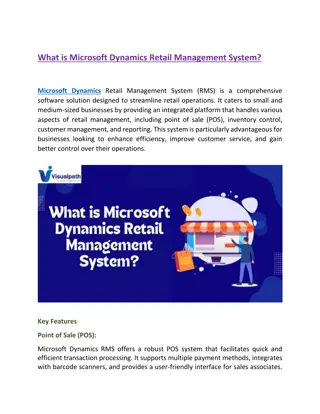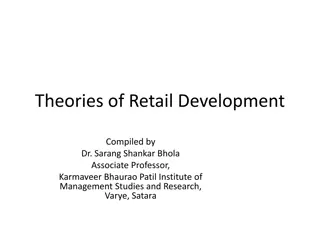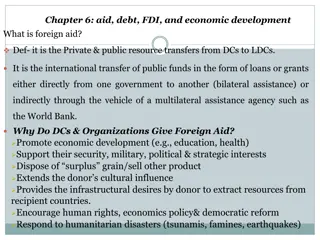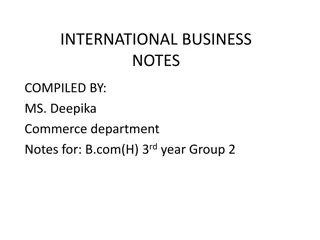Overview of Foreign Direct Investment (FDI) in Retail Sector
This article provides insights into Foreign Direct Investment (FDI) in the retail sector, focusing on single-brand and multi-brand retail, along with statistics on FDI in various countries. It discusses the restrictions and permissions related to FDI in retail in India, highlighting key players in the Indian retail market. Additionally, it touches on the evolution of FDI regulations and the current scenario in the cash-and-carry wholesale segment.
Download Presentation

Please find below an Image/Link to download the presentation.
The content on the website is provided AS IS for your information and personal use only. It may not be sold, licensed, or shared on other websites without obtaining consent from the author.If you encounter any issues during the download, it is possible that the publisher has removed the file from their server.
You are allowed to download the files provided on this website for personal or commercial use, subject to the condition that they are used lawfully. All files are the property of their respective owners.
The content on the website is provided AS IS for your information and personal use only. It may not be sold, licensed, or shared on other websites without obtaining consent from the author.
E N D
Presentation Transcript
BY: DR. JAGADISH SINGH , ASSOCIATE PROFESSOR AND HEAD, DEPT. OF ECONOMICS, HARISHCHANDRA, P.G.COLLEGE, VARANASI.
*Foreign Direct Investment (FDI)- *It is a direct investment into production or business in a country by an individual orcompany in anothercountry. *It can be either by buying a company in the target country or by expending operationsof an existing business in thatcountry.
Mauritius- 53%, Singapore- 11%, USA- 9%, Netherlands- 5%, Japan- 4%, Cyprus- 4%, Germany- 3%. UK 7%,
Single Brand-: Single brand implies that foreign companies would be allowed to sell goods sold internationally under a single brand , viz., Reebok, Nokia and Adidas. FDI in Single brand retail implies that a retail store with foreign investment can onlysell one brand. For example, if Adidas were to obtain permission to retail its flagship brand in India, those retail outlets could only sell products under the Adidas brand and not the Reebok brand, for which separate permission is required. If granted permission, Adidas could sell products under the Reebok brand in separate outlets. Multi Brand-: FDI in Multi Brand retail implies that a retail store with a foreign investment can sell multiple brands under one roof. Opening up FDI in multi-brand retail will mean that global retailers including Wal-Mart, Marks & Spencer and Tesco can open stores offering arrange of household items and grocerydirectly toconsumers in the samewayas the ubiquitous kirana store. .
Country Modern Retail (in 2011, % of total) India 7% China 20% Thailand 40% United States 85%
1-Pantaloon Retail- 65 stores and 21 factoryoutlets in 35 cities. 2-Shoppers Stop- 51 stores in 23 cities. 3-Spencers Retail- 200 stores in 45 cities. 4-Reliance Retail- 708 mart and supermarkets, 20 wholesale stores in 15 cities. 5-Bharti Retail -74 Easyday stores. 6-Birla- More 575 stores nationwide. 7-Tata Trent- 59 Westside mall stores, 13 hypermarkets Lifestyle Retail 15 lifestyle stores, 8 home centers Future Group 193 stores in 3 cities.
FDI in cash and carry(wholesale)brought under the automatic rout up to 51% investment in a single brand retail permitted, subject to press note-3(2006 series). Until 2011, foreign direct investment (FDI) was not allowed in multi-brand retail, forbidding foreign companies supermarkets, convenience stores or any retail outlets. Even single-brand retail was limited to 51 per cent ownership. In January 2011, India allowed 100 per cent FDI investment in single- brand stores, but imposed the requirement that the single brand retailer would have to source 30 percent of its goods from India. On 7 December 2012, India allowed 51 per cent FDI in multi- brand retail. Dr. Manmohan Singh, the prime minister of India, felt that this would be beneficial for both consumers and farmers. Agricultural marketing was also expected to be benefited with the introduction .CONTINUE from any ownership in of new technologies.
Manmohan Singh was credited with bringing about this policy change aimed at making India friendlier for businessmen. With this companies, especially the supermarkets, were able to increase their presence in the multi-brand retail sector of India. However, they were not allowed to own more than 51 per cent stakes in these establishments. This step was regarded as the most important one in the last two decades, especially with regard to reforms in India. decision, international
Indian market has high complexities in terms of a wide geographic spread and distinct consumer preferences varying by each region necessitating a need for localisation even within the geographic zones. While India opportunity given the number and increasing purchasing power of consumers, there are significant challenges as well given that over 90 per cent of trade is conducted through independent local stores. Challenges include: Geographically dispersed population, small ticket sizes, complex distribution network, little use of IT systems, limitations of mass media and existence of counterfeit goods. presents a large market
FDI up to 100% is permitted, under the automatic route, subject to certain conditions mentioned in Consolidated FDI Policy, in the following agricultural activities: Floriculture, Horticulture, Apiculture and Cultivation of Vegetables & Mushrooms under controlled conditions; Development and production of Seeds and planting material; Animal Husbandry (including breeding of dogs), Pisciculture, Aquaculture, under controlled conditions; and Services related to agroand allied sectors. 100% FDI is also permitted in tea sector. Besides the above, FDI is not allowed in anyotheragricultural sector/ activity. Policy for FDI in Multi-Brand Retail Trading (MBRT) provides that at least 50% of the first tranche of US $ 100 million shall be invested in back- end infrastructure which includes construction of warehousing and cold storages.
Advantages of FDI in Retail in India : (1)Growth in Economy (2) Job Opportunities (Approx. 10 million job creation.) (3) Benefits to Farmers (4) Benefits to consumers (5) Growth in Infrastructure Facilities (6) Cheaper Production facilities (7) Availability of new technology (8) Long term cash liquidity (9) FDI opens up a new avenue for Franchising (10) Foreign countries will also create a supply chain management in the Indian market. This will result in avoidance of food wastage and perishables.
1-Unorganised sector will be affected. 2-Limited Employment Generation. 3-Small retailers and other Kirana Stores may close down. 4-Supermarkets will establish their monopoly in the Indian market. 5-Exploitation of natural resources by foreign players. 6-Inflation may be increased. 7-An economically backward class person will suffer from price rise. 8-India will become slave due to entry of foreign players.
It can be said that the advantages of allowing unrestrained FDI in the retail sector evidently outweigh the disadvantages attached to it and the same can be deduced from the examples of successful experiments in countries like Thailand and China where too the issue of allowing FDI in the retail sector was first met with incessant protests, but later turned out to be one of the most promising political and economic decisions of their governments and led not only to the commendable rise in the level of employment but also led to the enormous development of their country's GDP. And also, nobody can force a consumer to visit a mega shopping complex or a small retailer/sabji mandi. Consumers will shop in accordance with their utmost convenience, where ever they get the lowest price, max variety, and a good consumer experience.
Prime Minister Modi has emphasized the role of manufacturing funded by domestic as well as FDI resources to ensure a more inclusive growth in the economy. Towards this end, the Government of India has recently announced several relaxations in policy to enable enhanced FDI inflows in sectors such as infrastructure, insurance and retail. Caps for FDI inflows have been raised which will ease the infusion of FDI funds. Apart from providing Indian consumers more choices in the form of reputed, good quality brands, liberalizing multi-brand retailing in India is likely to facilitate much greater inflows of investments. This, in turn, will lead to the development of moree fficient and lower cost supply chains, resulting in better quality as well as lower-priced products for Indian consumers.























